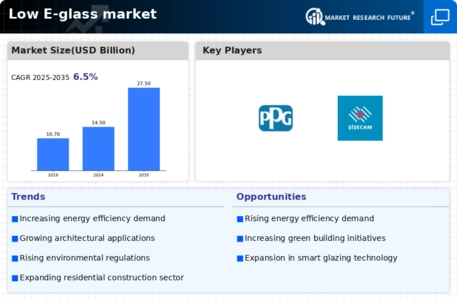Market Analysis
In-depth Analysis of Low E Glass Market Industry Landscape
The market dynamics of low-E (low emissivity) glass are shaped by a confluence of factors driven by the construction industry's emphasis on energy efficiency, environmental considerations, and technological advancements. Energy Efficiency in Buildings: The primary driver of the low-E glass market is the growing focus on energy efficiency in buildings. Low-E glass is designed to minimize heat transfer through windows by reflecting or absorbing infrared radiation. As buildings seek to meet stringent energy codes and improve sustainability, the demand for low-E glass in windows and facades is on the rise. Regulatory Push for Green Building Standards: The dynamics are significantly influenced by regulatory initiatives promoting green building standards. Many countries and regions are implementing building codes and standards that mandate energy-efficient practices. Low-E glass, with its ability to enhance insulation and reduce heating and cooling costs, aligns with these regulations, driving its adoption in construction projects. Advancements in Coating Technologies: Technological advancements in coating technologies play a crucial role in shaping the market dynamics of low-E glass. Innovations in coating materials and manufacturing processes contribute to the development of low-E coatings with improved performance characteristics, such as enhanced solar control and visible light transmission. Solar Heat Gain Coefficient (SHGC) Considerations: The market dynamics are influenced by the Solar Heat Gain Coefficient (SHGC), a key parameter in evaluating the performance of low-E glass. Low SHGC values indicate the glass's ability to block heat from the sun. As architects and builders aim to balance natural light with reduced heat gain, low-E glass with optimal SHGC values becomes a preferred choice. Growing Awareness of Environmental Impact: The dynamics of the low-E glass market are shaped by the growing awareness of the environmental impact of buildings. Energy-efficient solutions, including low-E glass, contribute to reducing carbon footprints by decreasing the need for artificial heating and cooling. This aligns with the broader sustainability goals of the construction industry. Variety of Low-E Glass Types: The market dynamics are influenced by the variety of low-E glass types available, each designed to address specific performance requirements. Single-pane, double-pane, and triple-pane configurations, as well as spectrally selective coatings, provide options for builders to choose low-E glass solutions tailored to their projects' needs. Impact on HVAC System Design: The adoption of low-E glass has implications for HVAC (heating, ventilation, and air conditioning) system design. By reducing the amount of solar heat entering buildings, low-E glass can contribute to the optimization of HVAC systems, leading to energy savings and increased efficiency. This interaction between building components shapes market dynamics. Residential and Commercial Construction Trends: Market dynamics are closely tied to trends in residential and commercial construction. The demand for low-E glass is influenced by the level of construction activity, as well as the preferences of homeowners, architects, and developers for energy-efficient and aesthetically pleasing building envelopes. Cost Considerations and Return on Investment (ROI): The dynamics of the low-E glass market are influenced by cost considerations and the perceived return on investment. While low-E glass may have a higher initial cost compared to traditional glazing, the long-term energy savings and increased comfort levels often justify the investment, impacting purchasing decisions in the construction industry. Global Economic Conditions: Economic conditions on a global scale contribute to the market dynamics of low-E glass. Economic growth, construction spending, and real estate development influence the demand for energy-efficient building materials. Fluctuations in global economic conditions can impact the overall adoption rate of low-E glass in construction projects.


 Source: Primary Research, Secondary Research, Market Research Future Database and Analyst Review
Source: Primary Research, Secondary Research, Market Research Future Database and Analyst Review


Leave a Comment